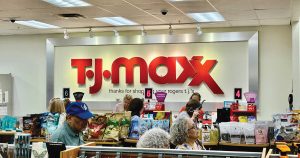The Supply Side: Winners, losers shake out in the off-price retail sector
by August 6, 2024 11:23 am 338 views

Off-price retail is popular with inflation-weary consumers looking for their favorite brands at a discount. But not all off-price retailers are cashing in. Ohio-based Big Lots recently announced plans to shutter up to 40 stores because of poor performance.
From its first store in 1982, the discounter largely focused on closeout retailing, buying excess inventory directly from manufacturers and selling it at a discount. The company grew its footprint to 1,342 stores in 48 states. But Big Lots’ sales fell by 10.2% to $1 billion in its first quarter, ending May 4. Comparable-store sales tumbled 9.9%. The retailer said about 6% of its store base is underperforming.
“While we made substantial progress on improving our business operations in Q1, we missed our sales goals due largely to a continued pullback of consumer spending by our core customers, particularly in high ticket discretionary items,” CEO Bruce Thorn said in the recent earnings release.
He said the company is taking aggressive actions to drive positive comp sales growth in the latter part of the year and into 2025 and to maintain year-over-year gross margin rate improvements. He also cited the company’s efforts to improve its liquidity.
“We are pleased with our actions to preserve and enhance liquidity in Q1, which included aggressive efforts to manage operating expenses, capital spending and inventory and the execution of a new $200 million term loan facility, which provides significant additional financial flexibility,” Thorn said.
Big Lots ended the first quarter of fiscal 2024 with $44 million of cash and cash equivalents and $573.8 million of long-term debt under its lending facilities. Analysts are less confident in Big Lot’s future, noting several issues other than less consumer spending and weak financial reports.

A large part of Big Lots’ focus in the past 18 months has been on expanding furniture sales, a category that continues to decline. Saunders said the gamble on furniture has not paid off, and too many stores were opened with loans on the assumption sales would improve. Saunders said stores have too much junk and not enough treasure.
“People want the thrill of the find, but there is not enough to find at Big Lots,” he noted.
Other off-price discounters, such as Tuesday Morning and Gordmans, that have faced similar issues, ended up in bankruptcy, ultimately shuttering all their stores.
“The shame of it is Big Lots should be performing well in a market where consumers have turned to value. That it isn’t, speaks to a broken strategy. I wish the company well, but it looks like bankruptcy is the ultimate destination,” Saunders noted.
Off-price retailers TJX and Ross Dress for Less tell a different story. TJX, which owns TJ Maxx, Marshalls and HomeGoods, reported sales rose by 6% to $12.48 billion, topping the 3% growth it saw a year ago. Ross Dress for Less posted an 8% jump in sales, lifting revenue to $4.86 billion, outpacing the 3.7% gain it posted in the prior-year period. TJX and Ross recently blew past analyst expectations.
TJX and Ross have each grown substantially since 2019, taking market share from department stores and other off-price players. Consumers are finding bargains on brands and being choosier about how much they spend.
Analysts at UBS said TJX and Ross offer designer brands in fashion, home, and beauty that consumers want. According to Goldman Sachs, the stores are well-merchandised and stay busy because they offer value and the opportunity to treasure hunt. Another reason TJX, Ross and Walmart are doing better than Big Lots is because they offer fast fashion that younger consumers want. BMO Capital Markets recently noted off-price winners like TJX and Ross are seen in a different light than other competitors.
“We need to also recognize that [TJX] convinced shoppers that they were fashionistas, not penny pinchers, and I think that was a very powerful and probably a healthy shift in mindset,” said Simeon Siegel, a retail analyst for BMO Capital Markets.
He said younger consumers see finding a favorite brand at a bargain as a badge of honor and are likely to share that news with friends.
The analysts also said off-price leaders have done a better job buying wholesale directly from manufacturers to have trendy and up-to-date styles instead of last year’s closeouts. Siegel said the aisles at a well-run, off-price retailer are not filled with junk, but they offer the kinds of household names consumers want such as Nike, Michael Kors or Ralph Lauren.
Editor’s note: The Supply Side section of Talk Business & Politics focuses on the companies, organizations, issues and individuals engaged in providing products and services to retailers. The Supply Side is managed by Talk Business & Politics and sponsored by Firebend.
